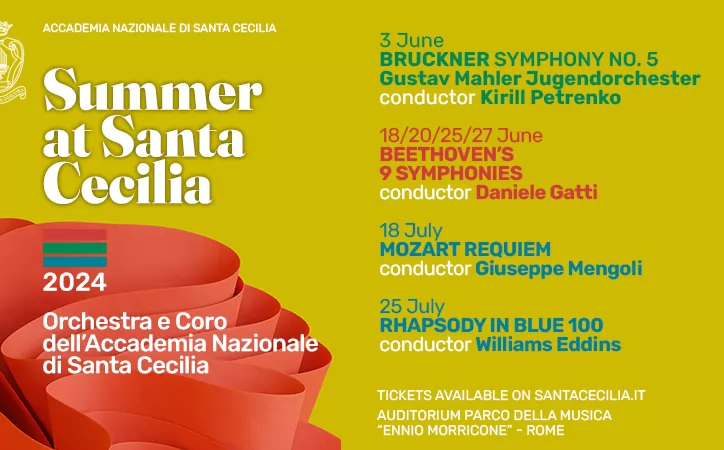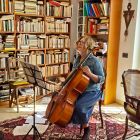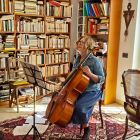The joys of fly-fishing.
The men stand in a line, adorned in feathered caps and fishing vests, preparing to cast. Eleven oclock and two oclock they say, back and forth. The lines snap forward then back, and then finally release, sending the bait on its way. The tiny man-made flies zig and zag, not so unlike the hectic flight patterns of their living counterparts, and finally reach the desired target: a 100-year-old cobblestone. No, the fish are not biting on this crisp night in Piazza S. Paolo, the walls of the famous basilica looming behind Romes finest fly-fishermen, who like this open space to practise casting. Over and over the men cast into the square, honing their craft while chatting about that huge fish caught last month, which somehow grows a kilo or so each time the story is told.
There are some pretty good fishermen inside the church too, baiting their hooks with the gospel, hoping to reel in a soul or two. Christ himself was known to fill the nets on occasion. In the square, these guys have more modest hopes: to leave the bustling avenues of Rome for a peaceful river and to outsmart a few trout.
The challenge lies in making a fool of a fish, explains Raff Santos, who has been fishing for a year now and is considered the only professional Filipino fly-fisherman in Italy. Thats what they tell me, anyway, he continues, referring to the collection of cast masters that fill the square. Santos is already somewhat of a legend to the group of close-knit veterans. On his first trip to a river he snagged seven fish, more than the other lifelong fisherman who accompanied him. All seven made it back to the river though, as this crew practises catch and release, not kill fishing.
Fly-fishing is nature-friendly. There are no worms, no barbed hooks to hurt the fish, Santos says. If you wanted to take home a bunch of fish, you might as well just throw a stick of dynamite into the river. Its about being in nature. Its kind of romantic.
Fly-fishing has become a labour of love too for Fabrizio Sabatini, owner of Crazy Fly, one of Romes few fly-fishing shops. His favourite fishing partner is his wife. When hes not working, hes fishing. When hes working, hes talking about fishing.
Its not important if you catch a fish. Its important that you understand why we catch fish, Sabatini says. His reasons are simple. He and his friends travel the world to test their skills at new rivers with new types of fish. He has a chance to be at one with nature, as he says. Plus, he gets to test out all the home-made flies he spends his days constructing.
You can buy a fly in a shop for a euro, Sabatini says. Its very rewarding to catch a fish with a fly you made yourself. He coolly slides a drawer open in his shop, and hundreds of creepy, crawly flies stare back at you. Upon close inspection, you see that its nothing more than a collection of hooks covered with rooster and peacock feathers, coloured thread and hares fur. In two minutes, Sabatini folds, wraps and tweaks until a tiny little fly emerges. He has made thousands, a different one for every river, a different one for every time of day.
Its not cheap though, this fly-fishing. A rod, reel, line, flies, boots and the necessary clothes can cost upwards of several hundred euros. Luckily, Sabatini asks his clients to come with him on a fishing trip near Rome, loaning out his own equipment, so a beginner can decide for him or herself whether or not to make the investment. Then there is the question of learning.
While cool nights in a church square are an excellent way to practise fly-fishing, they are no substitute for professional lessons at fly-fishing school. Enter Advanced Fly Casting School, directed by Piero Letizia. The school teaches casting as well as fly-tying, which is more of a basic lesson in entomology. After all, making string, feathers and a hook resemble a living insect isnt easy.
If I go fishing with just a worm, thats okay, a fine sport. But fly-fishing is about making a quality fly and a quality cast, says Letizia. Its a challenge and it takes skill.
The school offers group lessons anywhere in Italy, as well as guided fishing lessons in Sweden over the summer. In Piazza S. Paolo, other fishermen stand open-mouthed, watching Letizia. He deftly snaps his line to and fro, extending it to about 10 m before casting effortlessly. The man can cast.
I can say modestly that I am not the best but one of the best casters in the world because its never good to say youre the best, he says. But asking Letizia how good he is as a caster is like asking Michael Jordan how good he is at basketball. Hes that good.
Sabatini watches his friend Letizia and nods approvingly. There is no sense of competition to be the best caster or to catch the most fish. There is only admiration between friends.
There are no masters here, he says. There are no students. There are no secrets. We are just people who like to fish.
A licence is not needed for fly-fishing. There are certain rivers that are catch-and-release only, but signs are posted.
www.crazyfly.it, www.afcs-flyfishing.com.





















